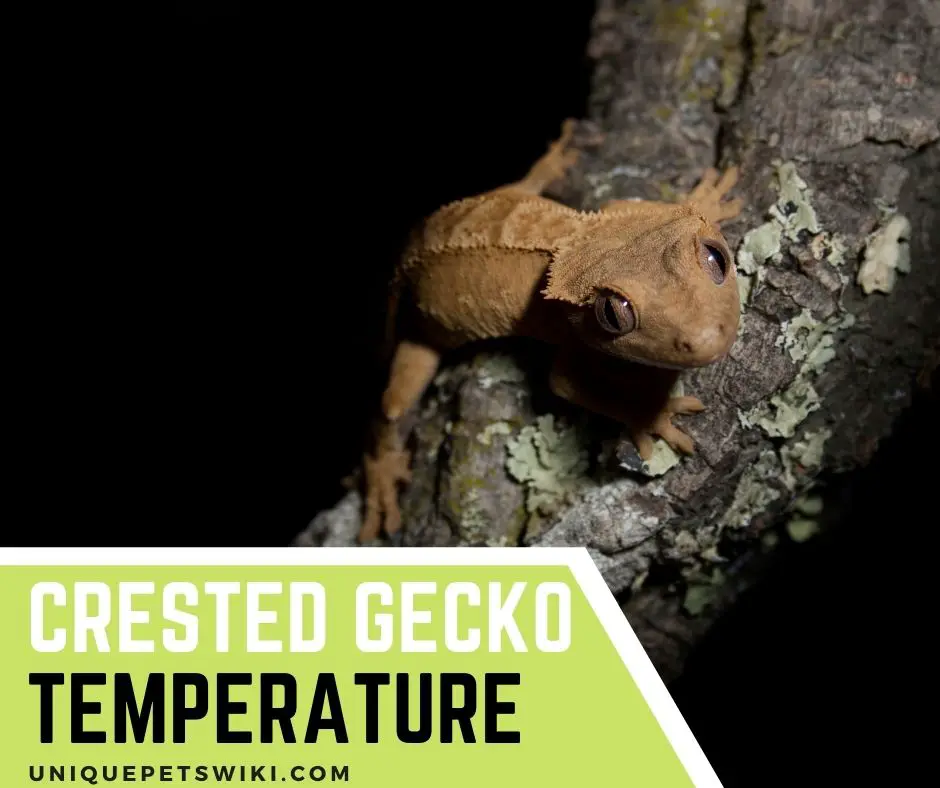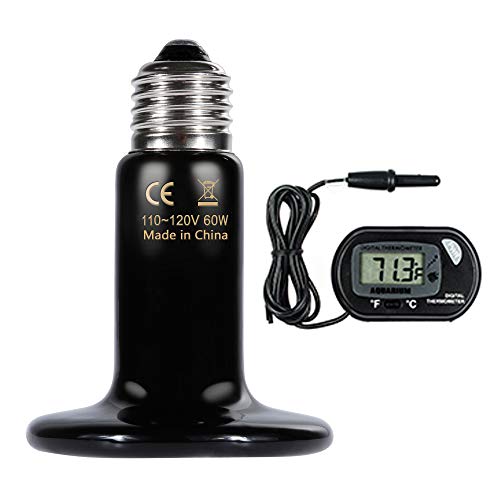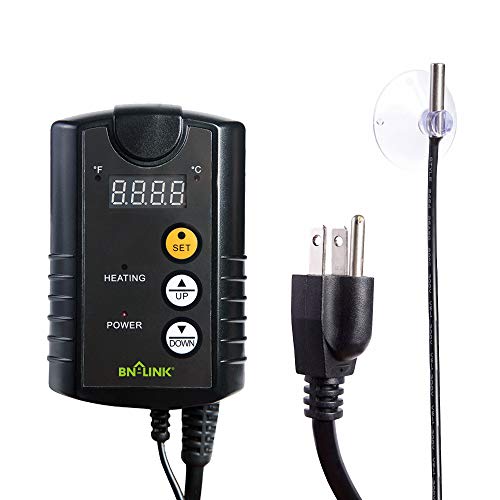Crested geckos are ectotherms, and thus, they require an external heat source to help them regulate their body temperatures. It is critical to provide them with adequate external heat to help them function properly.
Many people get confused about whether room temperatures are enough to keep their crested geckos healthy.
Therefore, we came up with this article to enlighten you on how much temperature crested geckos require to stay healthy and happy.
Also, we will give you three tips on how you can control and monitor your crested gecko temperatures. Keep reading!
Contents
Crested Gecko Temperature: How Is Good
Crested geckos being ectotherms, they depend on external heat sources to regulate their body temperatures. They use natural heat source “sunlight” to heat their bodies in the wild. In captivity, they require you to install a heat lamp to provide them with the necessary heat. Adequate temperatures help crested geckos digest their food properly and thus promote growth.
Daytime Temps for Crested Gecko
Crested geckos are hardy and can survive at room temperature. However, too little temperature can harm them.
Therefore, it is wise to know how much temperature you should provide in their terrarium. In the wild, crested geckos move from one place to another to regulate their body temperature.
For instance, they hide under the rocks to cool off their bodies when it’s hot. And, when it’s cold, they bask in the sun to warm their bodies.
In captivity, you should provide a similar setup to keep them comfortable. The ambient temperatures for crested geckos during the day should range between 72-780F, and the basking area temperature should range between 82-850F.
Consistent excessive temperature above 850F can cause stress and heat stroke to your crested gecko.

Nighttime Temperature for Crested Geckos
Crested geckos do not need external heating during the night unless the temperature is below 650F.
The room temperature for crested geckos during the night should range between 65 -720F. Too low temperatures for a while can cause your crested gecko to suffer from indigestion, poor appetite, lethargy, and sickness.
What Happens When Crested Geckos Get Too Cold/Hot?
Any temperature below 650F is considered too low, while above 850F is too high for crested geckos.
Too high or too low temperature is dangerous for crested geckos. Too low can lead to poor appetite, lethargy, and illnesses, while too high can cause stress and heat stroke.
Therefore, it is critical to maintaining an ideal temperature for crested geckos. In the wild, crested geckos use sun rays to warm up their bodies and branch and rock shades to cool off their bodies.
In captivity, it is the responsibility of the crested gecko’s owners to create a suitable temperature for their pets.
Suppose you live in areas where temperatures can fall below 500F during winter. In that case, you should consider using additional heating, such as a low-wattage incandescent lamp, to keep the temperature at bay.
Likewise, if you live in hot areas where the ambient temperature is above 850F for a consistent period, you should ensure to place your crested gecko terrarium in a cool place.
3 Tips to Monitor and Control an Ideal Temperature for Your Crested Gecko
For crested geckos to stay healthy and happy in captivity, they require their owners to provide a good ambient and surface temperature. Ambient temperature is the room or air temperature, while the surface temperature is the object temperature.
Both temperatures are paramount, and thus the crested gecko owner should monitor and control them equally.
This segment will give you pro tips on how you can control and monitor your crested gecko ambient and surface temperatures.
Use Some Source Heat to Warm Your Crested Gecko’s Enclosure
Like we stated earlier, it is imperative to provide your crested gecko with a thermal gradient temperature in their terrarium. This way, they can move to a high-temperature zone when it’s cold and too low-temperature zones when hot.
Providing such an environment for your crested gecko is not as complicated as understanding human emotions.
All you have to do is use some available devices such as heat lamps, heat emitters, heat panels, heat pads, or heat rocks to provide the required temperature in your crested gecko’s cage.
Heat Lamps
Heat lamps are the best heat source for crested geckos. They produce heat and light using the metal reflector dome and incandescent bulb.
The incandescent bulb produces light while the dome emits heat. Heat lamps come with different wattages, and high wattage heat lamps produce the most heat and vice versa.
Heat lamps are easy to use, easy to regulate the temperature and have low fire risks. However, they are expensive and can’t be used at night.

Heat Emitters
Heat emitters consist of ceramic elements that produce infrared long-wavelength heat raising the ambient temperature in a crested gecko cage.
They do not produce any lighting and are thus suitable for day and night. Also, they are more durable than heat lamps, and they can be used together with a thermostat.
On the other hand, they are more expensive than heat lamps, difficult to monitor, and exceedingly hot.
Heat Panels
Heat panels are most common for reptile and bird enthusiasts. They are a little like the heat emitters as they also produce long-wavelength infrared heat to warm the crested gecko terrarium.
However, they are better than heat emitters as they maintain a suitable temperature and do not get excessively hot.
Also, they are easy to install and can be used during the day and at night. However, they are even more expensive than heat emitters.
Last update on 2022-12-29 / Affiliate links / Images from Amazon Product Advertising API
Heat Pads
Heat pads are limited to glass terrariums as they can burn a plastic one. They are placed at the bottom of the tank and work almost the same as the heat emitters and heat panels.
They are cheap, easy to install, and can be used with a thermostat. However, heat pads are dangerous as they can easily burn your crested gecko in case of direct contact.
Also, they pose more fire risk compared to other heat sources.

Heat Rocks
Just like the name suggests, they look more like rocks, but they produce heat. The heat they produce is plenty compared to the heat pads. However, pose more threat to your crested gecko as they can easily cause contact burn.
Avoid Using Heat-Absorbing Substrates/ Substrate Is Too Hot
The substrate is the bedding material that covers the bottom of your crested gecko terrarium. Your crested gecko will spend plenty of time on the substrate.
Therefore, using a good substrate that does not absorb excessive heat is essential. Too much heat in the substrate affects the surface area of your crested gecko’s temperature.
Therefore, a bad choice of substrate will directly impact your crested gecko. Good substrate for crested geckos includes carpet, soil, wood shavings, moss, or even newspaper.
A good substrate should be able to absorb water, control odor, cover the floor, maintain a good temperature and humidity, and provide a natural feel for your crested gecko.
Install Thermometers in the Enclosure to Measure Temperature
Keeping temperatures at bay in a crested gecko’s tank is obligatory. You can only maintain the best temperatures if you can monitor.
The best way to monitor the temperature in your crested gecko’s cage is by installing thermometers.
You need to install at least two thermometers in your crested gecko’s cage for the best results. (One at the cool side and the other at the basking side).
Digital thermometers give better results than analogs. You can consider these digital thermometers for good and accurate results.
- BN-LINK Digital Heat Mat Thermostat Controller
- Zilla Digital Temperature Controller
- Zoo Med Labs Digital Thermometer Humidity Gauge
Last update on 2022-12-29 / Affiliate links / Images from Amazon Product Advertising API
Remember, the temperature is just one basic factor in keeping your crested gecko healthy. For you to provide a healthy, happy, long life for your crested gecko, you need to consider other factors such as habitat, lighting, humidity, and substrate.
To learn more about properly caring for your crested gecko, look out for our detailed articles on how to care for your crested gecko.
From UniquePetsWiki Owner: YOU SHOULD READ
Don’t say that you don’t have a heating source. As an owner, you MUST provide your pet with good care. Otherwise, please don’t get one. Thank you.
What is good care for crested geckos? Check our article: The Ultimate Crested Gecko Care Guide For Beginners.
Final Thoughts
Crested geckos are quite sensitive to temperature, and too much heat can cause stress and heat shock. Similarly, too cold temperature can lead to indigestion and other health issues.
Therefore, it is imperative to provide your crested gecko with an ideal temperature to help them thrive in captivity.
We hope that this article will help you take good care of your crested gecko.






